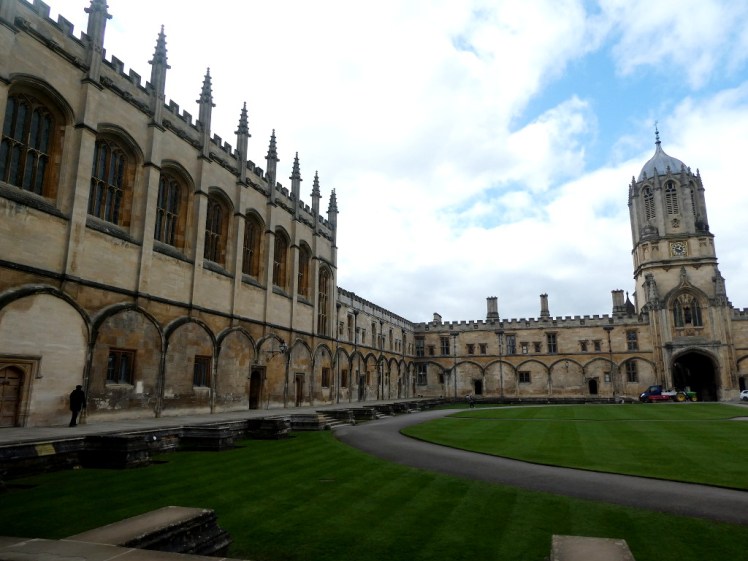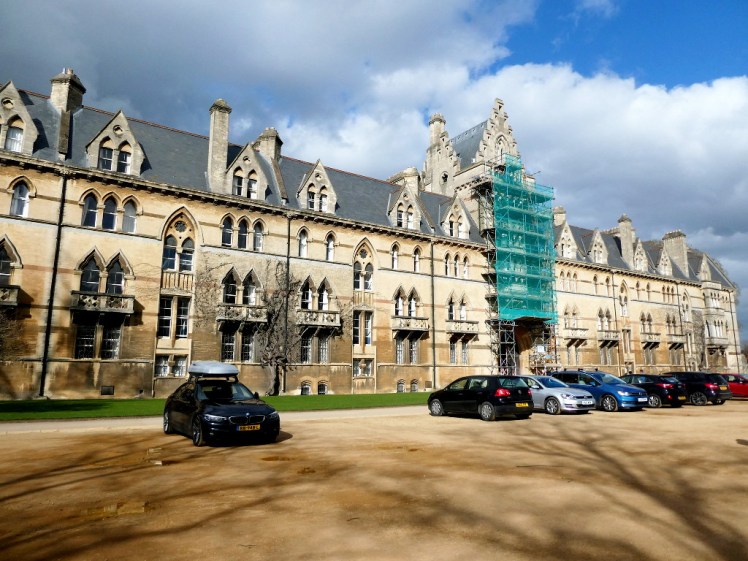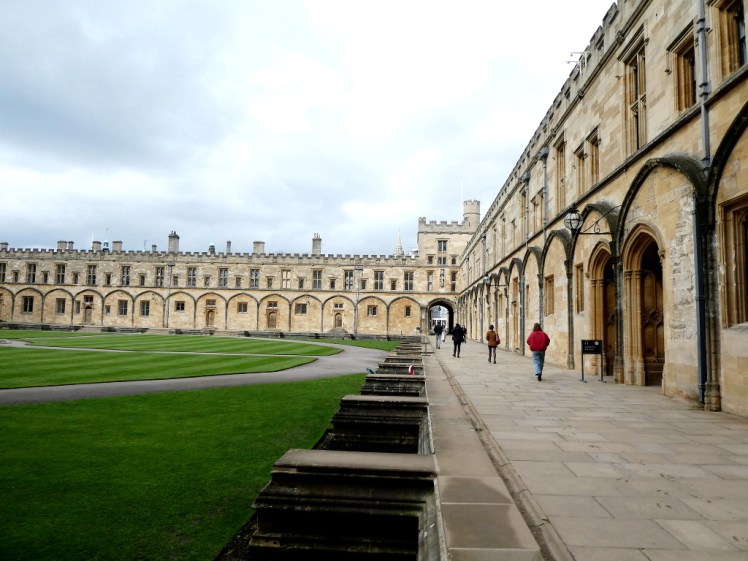Good morning! Today I’m finally in the mood to tell you about my trip to Oxford in March. It was before social distancing and lockdown and isolation and whatnot but after the virus got loose in the UK. To frame it precisely, I was supposed to be going to a gig and I really didn’t want to be in a dark crowded room with hundreds of strangers and was relieved when it got cancelled 24 hours before it started. That’s the stage of These Weird and Unprecedented Times we’re working in here.
The gig was Saturday night but if I was going to Oxford, I was going to cross off a cathedral on my #BeforeItBurnsDown list. For Oxford, that’s Christ Church Cathedral, which is within the college called Christ Church (an extremely awkward way to say “Christ Church College” without putting the words in that order, because they feel to put the word college in the name makes it sound like the cathedral isn’t just as important as the college).

Because I was there on the last day of the Hilary Term, all colleges were closed on Saturday so everyone could move out for the holidays – or, as it turns out, for the foreseeable future. That meant that if Christ Church was closed, I couldn’t get at the cathedral so I had to make a longer weekend of it by going up on Friday.
I went to a collegiate university but colleges at Kent work much like houses at my junior school, in that everyone’s a member of one but it doesn’t really affect your day-to-day life. My understanding of Oxbridge colleges is that you more or less live, sleep, study and work in your college for your whole three or four or however many years. That feels claustrophobic to me but what do I know?

That said, I could picture myself at Christ Church. Of course that’s the one I’m leaning towards. There are too many for me to investigate all of them in any depth at all and Christ Church is the one I’ve visited… but it’s the one whose college chapel is also an Anglican cathedral. The college is built around three quads, the biggest of which is the biggest of any Oxford college. It’s all so Oxford. Big yellowish stone college with towers and spires, built around a quad that visitors aren’t allowed to walk on. My ticket was for the entire college, not just for the cathedral. You can’t do a lot – just walk along the bottom of Tom Quad and around the corner into the other and go into the Great Hall – which I’ll get to later.

By Anglican cathedral standards, Christ Church is small. It was never built to be a cathedral. It was a priory, which survived Henry VIII because Christ Church was Cardinal Wolsey’s pet project. One of its earlier names was Cardinal College and you’ll spot his famous hat everywhere – in the stained glass, in the ceiling bosses, on the walls. So it’s quite an old building – in fact, it’s my favourite kind of church. It’s a messy mixture of Gothic and Norman architecture. Oh, I love Norman and I love Gothic and I love it when the two get mixed together.

The nave is good solid Norman, with good solid stone three-level round-arched walls but then the ceiling, especially down at the chancel end, is glorious fan vaulting. The aisles are Gothic and I’m not entirely sure what the cloisters are, because they came with the original priory and I don’t know very much about ecclesiastical architecture. It has a lovely weird kind of modern stained glass window of a style I’ve never seen before, a stained glass Jonah and his background and landscape in painted glass, and it has a chapel to St Frideswide, with a lovely statue of her. She’s the patron saint of Oxford and of the university, she was a princess and an abbess and she fled rather than marry Æthelbald, a king of Mercia. The stained glass window over her tomb tells that story. It’s an empty tomb; the bones are long gone. This all happened somewhere around the eighth century, I think.





Since I had the ticket and since it seemed to be a big deal, I thought I’d go and look at the Great Hall. Visitors to Christ Church are more interested in the dining hall than in the cathedral because there are more Potterheads in the world than cathedral architecture fans. Yeah, it turns out Christ Church’s Great Hall is also Hogwarts’ Great Hall and a lot of the people traipsing around it are wearing stripy scarves or carrying house-themed bags. I’ve read the books lot of times. I try to reread the entire series every year, although I’ve missed it the last couple of years. I’m re-reading them right now! But I’ve never seen the films and so I was utterly oblivious to the fact that I was walking up the front steps of Hogwarts or walking into the Great Hall.

For a student dining hall, it’s amazing. For a magical Great Hall, it’s a bit on the small side. The maths doesn’t work out but if you assume 10 kids per house per year, that’s 70 kids per house in total, so 240 kids in the entire school. Give or take that among Harry’s Gryffindor pals, the house and class that we spend six years with, only five boys and three girls get named. But in book 3, three-quarters of the Quidditch crowd is in red but there are 200 students in green, which makes 800ish students who’ve bothered to go out and watch the Quidditch, which I think makes about 1000 students in total. And this room isn’t big enough for 1000. It’s not even big enough for Christ Church’s 630ish students to all eat at once, if I remember the audioguide correctly.

But for a canteen… yeah. Norman-esque stone walls, vaulted wooden ceiling, wood paneling covered in oil paintings, tables the length of the room illuminated by lamps. Picture 2020’s 18-22 year olds sitting here. It’s one thing for the staff, who must have been grown in the soil of Oxford, floating around in their gowns, but 21st century teenagers, coming in here for their meals? That feels weird. Now, let’s be fair. A good proportion of those teenagers have probably come from fee-paying schools and for some of them, this is merely a continuation of what they’ve known for their entire school life.

And my own school dining hall wasn’t entirely unlike this, except a quarter of the size and utterly impractical for eating in, which is why first everyone who had school dinners ate in the surrounding classrooms and then they built a glass conservatory-esque canteen. My school was a comprehensive school but it was in an old manor house and known to the local primary schools as “The Manor”. I feel like I need to add that I had packed lunches and although where me and my friends went to eat them varied pretty much every year, I’m fairly sure that at least three out of five years we were in various temporary mobile classrooms – room 49 in year seven (mobile geography room), room 56 in year eight (mobile English room), in the manor house in room 4 in year nine and ten and in the hall down in the village in year eleven (huge mobile house room), after the first fire. Then we went into sixth form and we lived in the common room or the goon room (the room next to the common room) off the back of the manor house or the small room off the library.

No wonder I feel like I could live in Christ Church, then. My own comprehensive school didn’t look entirely unlike this. After the first fire, our summer concerts were given “on the terrace” and the music lesson rooms were up in the attic. The whole place was a fraction of the size of Christ Church and the vast majority of the school was modern buildings scattered around the top of the school grounds – there were actually only four classrooms in the manor house itself and only three in actual regular use. Oh, I was made for Oxford!
Well, no, I wasn’t. I was academically inclined in primary school but less so every year as I worked my way up through the school and I really do think I would have found Oxford very claustrophobic. Would I have found Oxford’s caving club? They’re supposed to be pretty good but I don’t remember ever meeting them at national events or in holes in the ground at weekends. Would Oxford language students have been sleek blonde girls I didn’t have any natural affinity with? Would I have been living with them as well as working with them?

And did I care about cathedral architecture when I was seventeen and applying to UCAS? No. Otherwise I’d have been to Canterbury Cathedral before my graduation day.